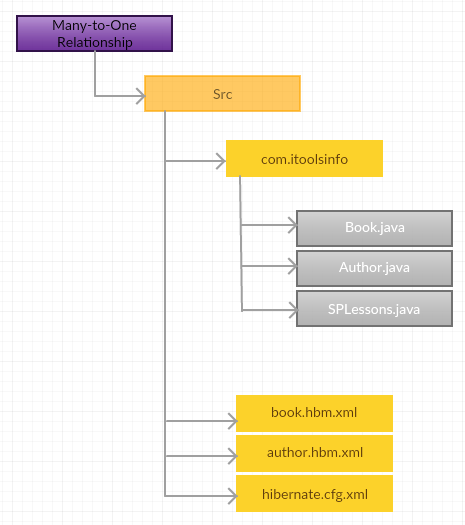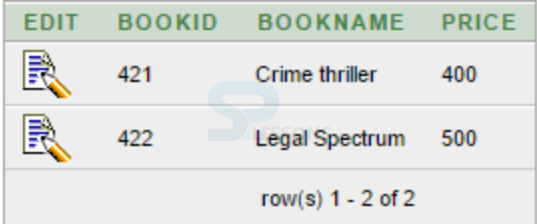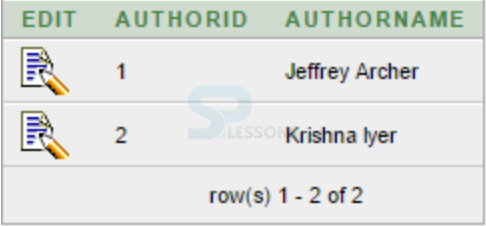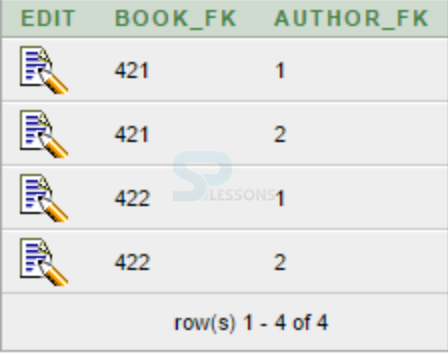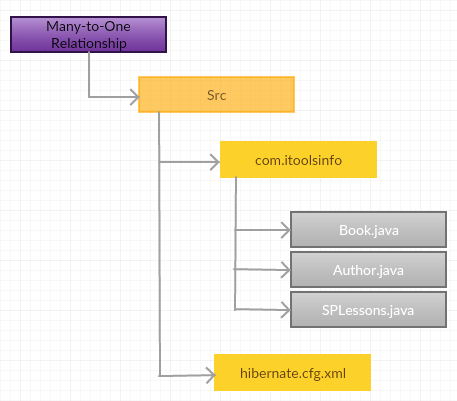 Description
Description
Hibernate Many to Many is a combination of one-to-many and reverse of one-to-many. When creating a POJO class, one need to use the reference variable of type collection. Hibernate Many to Many relationship means applying one-to-many relationship on both sides in two POJO classes means it is bidirectional. Collection property will be used while using Hibernate Many to Many mapping.
For Example, the Book class and Author class must implement Hibernate Many to Many relationship, because it is one book as many authors(one-to-many) and one author as many books(one-to-many). In a Database, Hibernate Many to Many relationship is not applicable to two tables. .So use the third table. This third table is called as Join table. It will store foreign keys of two tables.
 Examples
Examples
Following is an example for Hibernate Many to Many.
- Create the project directory structure.
- Create the persistence classes.
- Map the persistence classes in mapping file.
- Configure the mapping files in Configuration file.
| Properties | Description |
|---|---|
| hibernate.connection.driver_class | The JDBC driver class. |
| hibernate.dialect | This property makes Hibernate generate the suitable SQL for the picked database. |
| hibernate.connection.url | The JDBC URL to the database instance. |
| hibernate.connection.username | The database username. |
| hibernate.connection.password | The database password. |
| hibernate.connection.pool_size | Limits the number of connections waiting in the Hibernate database connection pool. |
| hibernate.connection.autocommit | Allows autocommit mode to be used for the JDBC connection. |
- Create the SPLessons class and store the POJO class objects, to perform the database operations.
In Many-to-Many relationship, two annotations must be used.
1. @ManyToMany(cascade = {CascadeType.ALL})
2. @JoinTable(name="Join table name", joinColumns={@JoinColumn(name="foreign key column name")}, inverseJoinColumns={@JoinColumn(name="other class foreign key column")})
- Create the project directory structure.
- Create the persistence classes with Annotations.
- Configure the persistence classes in Configuration file.
| Properties | Description |
|---|---|
| hibernate.connection.driver_class | The JDBC driver class. |
| hibernate.dialect | This property makes Hibernate generate the suitable SQL for the picked database. |
| hibernate.connection.url | The JDBC URL to the database instance. |
| hibernate.connection.username | The database username. |
| hibernate.connection.password | The database password. |
| hibernate.connection.pool_size | Limits the number of connections waiting in the Hibernate database connection pool. |
| hibernate.connection.autocommit | Allows autocommit mode to be used for the JDBC connection. |
- Create the SPLessons class and store the POJO class objects, to perform the database operations.
 Key Points
Key Points
- Hibernate Many to Many - Join table is utilized in many to many mapping to keep primary key as foreign key.
- Join table will have only foreign keys.




